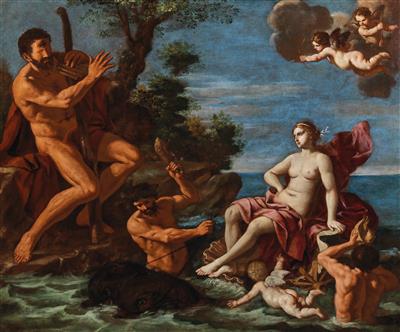Giacinto Gimignani

(Pistoia 1606–1681 Rome)
Polyphemus and Galatea,
inscribed lower left: IN Poussin.,
oil on canvas, 124.5 x 149.5 cm, framed
We are grateful to Ursula Verena Fischer Pace for confirming the attribution of the present painting and for her help in cataloguing this lot. She intends to include the present painting in her forthcoming expanded edition of her monograph on the artist.
The painting depicts the episode from Ovid’s Metamorphoses of the Cyclopes Polyphemus, who falls in love with the beautiful sea-nymph Galatea but loses her to the youthful Acis; and so, out of rage, he throws a rock at him. The picture shows the moment the Cyclopes falls in love. Galatea approaches the giant on her shell carriage. Polyphemus is depicted seated on a rock, playing on his reed pipe attempting to win Galatea for himself.
Gimignani frequently depicted mythological subjects, which he rendered in a delicate and refined way often drawing inspiration from Carracci’s Loves of the Gods in the Galleria Farnese, Rome. He was less interested in the drama of the story but, as can be seen in the present painting, in the contrast of the ideally modelled body of a female nude and that of a crude naked giant, who has been placed here in a seascape with vegetation and the rippled sea in the foreground.
The inscription demonstrates Gimignani’s highly personal variant of the classical style within Roman painting of the Seicento, which was closer to his French contemporaries than to the High Baroque istyle exemplified by Bernini and practiced by Giovanni Battista Gaulli. The noticeable abandonment of a decisive Cortonesque orientation may be observed at the beginning of Gimignani’s career and goes hand in hand with a more subtly and richly nuanced palette. It seems most plausible that the present painting was executed in Florence in the early 1650s.
The estate inventory of his Roman household in via Felice drawn up after the artist’s death lists several paintings of related subject matter (see U. V. Fischer, Giacinto Gimignani [1606–1681]. Eine Studie zur römischen Malerei des Seicentos, doctor’s thesis, Freiburg 1973).
Expert: Mark MacDonnell
 Mark MacDonnell
Mark MacDonnell
+43 1 515 60 403
old.masters@dorotheum.com
09.06.2020 - 16:00
- Odhadní cena:
-
EUR 20.000,- do EUR 30.000,-
Giacinto Gimignani
(Pistoia 1606–1681 Rome)
Polyphemus and Galatea,
inscribed lower left: IN Poussin.,
oil on canvas, 124.5 x 149.5 cm, framed
We are grateful to Ursula Verena Fischer Pace for confirming the attribution of the present painting and for her help in cataloguing this lot. She intends to include the present painting in her forthcoming expanded edition of her monograph on the artist.
The painting depicts the episode from Ovid’s Metamorphoses of the Cyclopes Polyphemus, who falls in love with the beautiful sea-nymph Galatea but loses her to the youthful Acis; and so, out of rage, he throws a rock at him. The picture shows the moment the Cyclopes falls in love. Galatea approaches the giant on her shell carriage. Polyphemus is depicted seated on a rock, playing on his reed pipe attempting to win Galatea for himself.
Gimignani frequently depicted mythological subjects, which he rendered in a delicate and refined way often drawing inspiration from Carracci’s Loves of the Gods in the Galleria Farnese, Rome. He was less interested in the drama of the story but, as can be seen in the present painting, in the contrast of the ideally modelled body of a female nude and that of a crude naked giant, who has been placed here in a seascape with vegetation and the rippled sea in the foreground.
The inscription demonstrates Gimignani’s highly personal variant of the classical style within Roman painting of the Seicento, which was closer to his French contemporaries than to the High Baroque istyle exemplified by Bernini and practiced by Giovanni Battista Gaulli. The noticeable abandonment of a decisive Cortonesque orientation may be observed at the beginning of Gimignani’s career and goes hand in hand with a more subtly and richly nuanced palette. It seems most plausible that the present painting was executed in Florence in the early 1650s.
The estate inventory of his Roman household in via Felice drawn up after the artist’s death lists several paintings of related subject matter (see U. V. Fischer, Giacinto Gimignani [1606–1681]. Eine Studie zur römischen Malerei des Seicentos, doctor’s thesis, Freiburg 1973).
Expert: Mark MacDonnell
 Mark MacDonnell
Mark MacDonnell
+43 1 515 60 403
old.masters@dorotheum.com
|
Horká linka kupujících
Po-Pá: 10.00 - 17.00
old.masters@dorotheum.at +43 1 515 60 403 |
| Aukce: | Obrazy starých mistrů |
| Typ aukce: | Salónní aukce |
| Datum: | 09.06.2020 - 16:00 |
| Místo konání aukce: | Wien | Palais Dorotheum |
| Prohlídka: | 02.06. - 09.06.2020 |
Všechny objekty umělce
